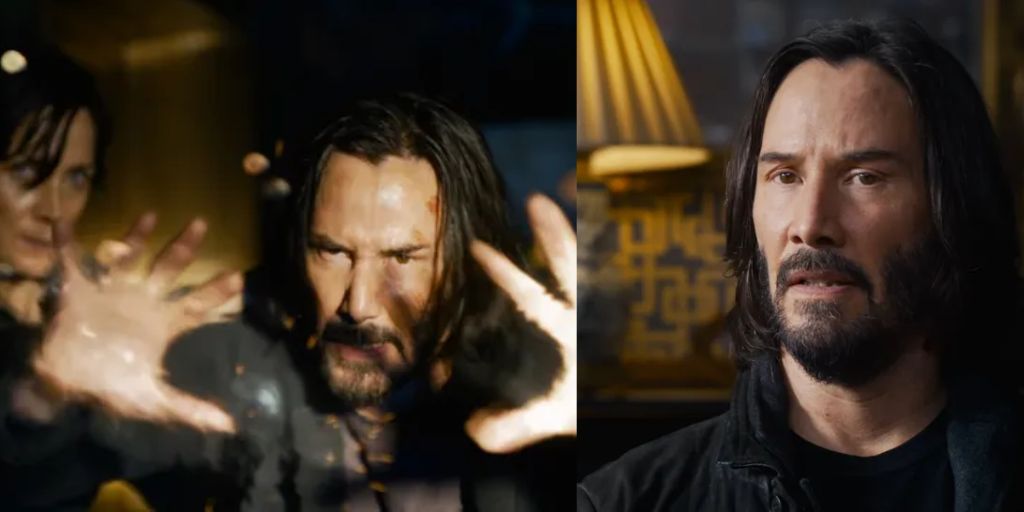
The Matrix Resurrections builds upon the legacy of the original trilogy but frames Neo’s return in a different light. After years of peace, Neo is reinserted into a fabricated simulation created by the machines.
In this digital prison, he lives as Thomas Anderson, a renowned game developer who believes the Matrix is merely the plot of his video games. This reality suppresses his memories of the past while keeping him under close observation.
Central to this deception is “The Analyst,” an upgraded program who took over after the Architect and the Oracle. The Analyst designed this version of the Matrix to control humans more efficiently by harvesting emotional tension: specifically the longing, fear, and desire between Neo and Trinity.
Neo begins questioning his reality once again, triggered by a chain of events orchestrated by Bugs, a new rebel leader working outside the system. She and her crew discover that Neo’s subconscious signals are still alive in the Matrix and begin a mission to free him.
Eventually, Neo is awakened but learns that Trinity is also alive, though trapped under the name “Tiffany,” a suburban mother who is suppressed by her own rewritten identity. The Analyst maintains control by ensuring Neo and Trinity remain close but never truly connect, since their bond generates immense energy when fully realized.
The film’s final act focuses on Neo attempting to reconnect with Trinity, break her free from this conditioning, and ultimately challenge the Analyst’s control over the Matrix once and for all.
Also Read: Elemental Ending Explained: Love Defies Boundaries of Fire and Water
The Story Breakdown: Trinity Awakens and the Analyst Falls
The true climax of The Matrix Resurrections revolves around Trinity’s awakening. While Neo has been portrayed throughout the franchise as “The One,” this installment redefines power dynamics. Neo approaches Trinity in the simulated world, asking her to decide whether she wants to embrace her forgotten identity.
Instead of dragging her out against her will, he allows her to choose. This marks a major thematic shift in the series, emphasizing agency, mutual love, and the shared bond between two equals.
At first, Trinity hesitates. When “Tiffany” is confronted, the Analyst tries to reaffirm her fake life by bringing in her artificial husband and children, created to emotionally anchor her within the Matrix.
But Trinity rejects this constructed identity, remembering her past connection with Neo. The moment she declares her true self, she regains her powers, and the system destabilizes.
The Analyst, angered by the disruption, tries to assert his authority. His control of the Matrix relies on manipulating emotions, which he believes are more effective than the old Architect’s rigid logic. However, Trinity’s choice dismantles this manipulation.
For the first time, The Analyst witnesses the collapse of his carefully designed system as Neo and Trinity take flight together. Interestingly, the film shifts the traditional “savior” role.
Trinity is the one who first demonstrates the power of flight in the Matrix’s final battle sequence, signaling that the partnership between the two is now the source of strength, rather than Neo alone.
This climax isn’t just about defeating a program; it is the rewriting of what power means within the Matrix. Instead of a singular chosen one, the system is now challenged by a partnership rooted in both freedom and love.
Ending Explained: What the Final Scenes Truly Mean
After their escape from the Analyst’s forces, Neo and Trinity confront him directly. Instead of a climactic fight like in past entries, this ending chooses a more symbolic confrontation. The Analyst, smug and manipulative, claims that humans need his version of the Matrix.
He argues that fear and longing make people easier to control, and that the majority actually prefer the illusions he provides. For him, the greatest tragedy is not oppression, but humans living without comfort.
Neo and Trinity reject this philosophy. They point out that regardless of how much control programs like the Analyst exert, choice matters.
Their existence and love prove that resistance can manifest not only in war but in personal freedom. As they stand together, powers restored, they proclaim their intention to rebuild the Matrix “their way.” By promising to reshape this reality, they imply that the next era is not about destruction but about reformation.
The significance of the ending lies in the shared equality between Neo and Trinity. While the original trilogy elevated Neo as the singular hero whose sacrifice ended the war, this chapter highlights a different ending: survival, choice, and renewal through partnership.
By flying together across the city in the film’s closing moments, they symbolize the rewriting of both the programmatic rules of the Matrix and the narrative structure of the franchise itself.

Many viewers expected another large-scale war, an apocalyptic battle, or Neo’s sacrifice once again. Instead, the film subverted these expectations with a quieter but more thematic ending. Its message is that liberation is not achieved by one; it is sustained by shared willpower and belief.
Themes at the Core of the Ending
-
Choice Over Control: The Analyst represents manipulation and subtle coercion, while Neo and Trinity represent freedom. By emphasizing Trinity’s choice in rejecting her false identity, the film solidifies the franchise’s longstanding theme of human agency.
-
Partnership Over the Lone Hero: Unlike the first films, Neo does not save Trinity; they save each other. Power now belongs equally to both, rewriting the narrative of “The One” into “The Two.”
-
Rewriting Legacy: Instead of repeating Neo’s sacrificial arc from Revolutions, Resurrections ends with hope. The message is that the past cannot simply be repeated; it must be reshaped.
Why the Ending Feels Different from the Trilogy
The conclusion of The Matrix Resurrections stands apart because it isn’t about final closure but about new beginnings.
While The Matrix Revolutions ended with peace achieved through Neo’s death, this installment chooses life, partnership, and possibility. The Analyst tries to convince Neo and Trinity that humans prefer being pacified. Yet, by flying together, the protagonists reject inertia and prove that transformation is possible.
Instead of showing the humans immediately freed or the machines destroyed, the film leaves space for imagination. What Neo and Trinity will build remains uncertain, but the central point is that they now carry the authority to reshape the entire Matrix.
The ending is less about war and more about philosophy: love as energy, choice as liberation, and shared strength as the new design for the future of humanity.
Also Read: Luca Ending Explained, Friendship, Change, and Moving Forward








